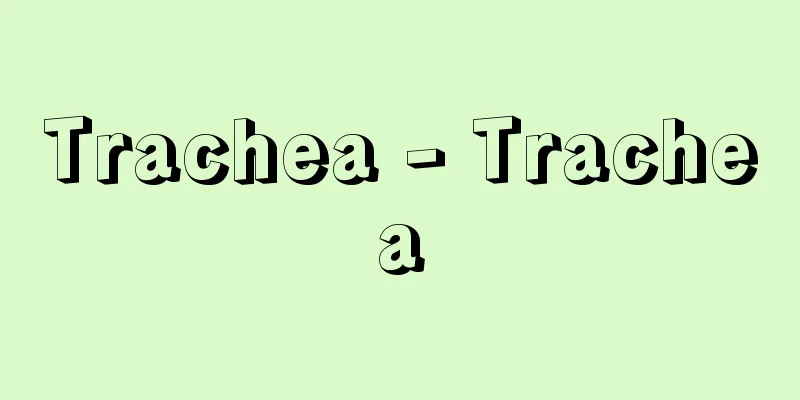Trachea - Trachea

|
Behind the thyroid cartilage in the front of the neck is the larynx, followed by the trachea, a tubular airway that descends almost vertically downward. The trachea begins at the lower edge of the cricoid cartilage, which is located below the thyroid cartilage, at the level of the sixth (or seventh) cervical vertebra. In Japanese adults, it is about 10 centimeters long (8.5 to 12.5 centimeters) and about 2.5 centimeters thick. The upper part of the trachea is in the neck, and the short lower part extends into the thoracic cavity and splits into the left and right bronchi at the level of the fourth to sixth thoracic vertebrae. There are 16 to 20 C-shaped tracheal cartilages (hyaline cartilages) in the wall of the trachea, which are arranged at regular intervals up and down with the back open. This plays a role in preventing the airway from collapsing and closing due to external pressure. The cartilages are connected to each other by the annular ligament. The opening of the posterior wall of the trachea is lined with a membranous wall of smooth muscle, and is strongly attached to the esophagus at the rear of the trachea by connective tissue. The mucous membrane of the inner surface of the trachea is composed of pseudostratified ciliated epithelium (called pseudostratified ciliated epithelium in zoology), and among these epithelial cells are goblet-shaped cells that secrete mucus. The cilia move upwards. The lower layer of the mucous membrane contains a large number of elastic fibers, as well as the tracheal glands, which are mixed glands that secrete mucus and serous fluid. The scientific name trachea comes from Greek and means "rough surface." At the time, arteries were thought to be tubes with a smooth inner surface through which air passes, and the trachea was thought to be a tube with a rough inner surface through which air passes. [Kazuyo Shimai] Animal tracheaIt is a semi-cylindrical tube that forms part of the airway of vertebrates that breathe air, and continues to the larynx. Its lower end branches into the left and right bronchi, which connect to the lungs. The length of the trachea is affected by the length of the neck and the position of the lungs, and is generally long in birds, and in swans in particular, the trachea is bent and looped (like a string or a cord) before connecting to the bronchi. In contrast, in anuran amphibians, the lungs are formed immediately after the larynx, so the trachea is extremely short. The tracheal wall has ring-shaped (birds, etc.) or horseshoe-shaped (mammals, etc.) tracheal cartilages at regular intervals, which act as supports to prevent the trachea from being compressed and closing. At the branching point of the bronchi in birds, there is a bulge that serves as a special sound-producing organ called the syrinx. The mucosal epithelium of the tracheal lumen is pseudostratified ciliated epithelium, and the ciliary movement is toward the larynx, helping to expel foreign bodies. On the other hand, in the aerial trachea of arthropods such as spiders, diplopods, chelipeds, and insects, as well as in the prototrachea of clawed animals such as hookworms, the epidermis of the body surface becomes thin tubes that enter the body and branch out to form a dendritic or tufted tracheal system. In these cases, the tracheal wall is the same as the epidermis, and on the inside there is a chitin layer called the tracheal endothelium, which has a thin spiral-shaped protuberance on its surface. The outside is lined with a layer of dermal cells. The trachea branches into bronchi, which branch out further and become thinner, ending in tracheal twigs. The openings of the trachea to the outside world are the spiracles, and air enters through the spiracles during breathing, and gas exchange occurs through the cells of the tracheal twigs. [Yasumi Arai] [Reference] | |©Shogakukan "> Animal trachea Source: Shogakukan Encyclopedia Nipponica About Encyclopedia Nipponica Information | Legend |
|
頸部(けいぶ)の前面にある甲状軟骨の後方が喉頭(こうとう)で、これに続いて下方へ向かってほとんど垂直に下降する管状の気道が気管である。気管は第6(または第7)頸椎(けいつい)の高さで、甲状軟骨の下側にある輪状軟骨の下縁から始まる。長さは日本人成人で約10センチメートル(8.5~12.5センチメートル)であり、太さは約2.5センチメートルである。気管の上方の部分は頸部にあり、短い下方の部分は胸腔(きょうくう)内に延びて第4~第6胸椎の高さで左右の気管支に分かれる。気管の壁には16~20個のC型の気管軟骨(硝子軟骨(ガラスなんこつ))があり、後方が開いた位置で上下に一定間隔で配列している。これは、外圧力によって気道がつぶれ、閉鎖されるのを防ぐ役割を果たしている。軟骨と軟骨との間は輪状靭帯(じんたい)でつながっている。気管後壁の開方部は平滑筋の膜性壁が張られていて、気管の後部にある食道とは強く結合組織で固着している。気管の内面の粘膜は多列線毛上皮(動物学では多列繊毛上皮と書く)で構成され、この上皮細胞のなかには粘液を分泌する杯状細胞が混在する。線毛は上方に向かって運動している。粘膜の下層には多量の弾性線維があるほか、粘液と漿液(しょうえき)を分泌する混合腺(せん)である気管腺がある。なお、学名のtracheaの語源はギリシア語からで、「粗面」を意味している。当時にあっては、動脈は内面が平滑な、空気の通る管であり、気管は内面が粗な、空気の通る管と考えられていた。 [嶋井和世] 動物の気管脊椎(せきつい)動物のうち空気呼吸する動物の気道の一部をなし、喉頭に続く半円筒状の1本の管で、その下端は分岐して左右の気管支に分かれ肺に連なる。気管の長さは、頸(くび)の長さや肺の位置による影響を受け、鳥類では一般に長く、ことにハクチョウなどでは、気管支に続く前に途中で屈曲してループ状(糸紐(ひも)などの輪状)になっているものがある。逆に無尾両生類では、喉頭からすぐ肺になるので、気管はきわめて短い。気管壁には輪状(鳥類など)または馬蹄(ばてい)形(哺乳(ほにゅう)類など)の気管軟骨が一定の間隔で入っており、気管が圧迫されて閉ざされないように支柱の役目を果たしている。鳥類の気管支の分岐部には膨らみがあって特別な発音器となり、鳴管(めいかん)とよばれる。気管の管腔(かんこう)の粘膜上皮は多列繊毛上皮で、繊毛運動の方向は喉頭へ向かい、異物の排出に役だっている。 一方、節足動物の有気管類に属するクモ類・倍脚類・唇脚類・昆虫類のほか、有爪(ゆうそう)動物の原気管類に属するカギムシなどは、体表の表皮が細管となって体内に進入し、分岐して樹枝状または房状の気管系を形成する。したがってこの場合、気管壁は表皮と同じで、内面には気管内膜とよばれるキチン層があり、その層の表面に細い螺旋(らせん)状の隆起構造をもつ。外面は1層の真皮細胞が裏打ちしている。気管は分岐して気管支になるが、さらに分岐して細くなり、その終末は気管小枝とよばれる。気管の外界への開口部は気門で、呼吸運動によって気門から空気が入り、気管小枝の細胞を介してガスの交換が行われる。 [新井康允] [参照項目] | |©Shogakukan"> 動物の気管 出典 小学館 日本大百科全書(ニッポニカ)日本大百科全書(ニッポニカ)について 情報 | 凡例 |
>>: Kigali - Kigali (English spelling)
Recommend
Exobasidium camelliae (English spelling)
…[Tsubaki Keisuke]. . . *Some of the terms that m...
Elsaß-Lothringen
The name given to the regions of Alsace and Lorra...
Pit grave - Dokoubo
A human burial facility from the Yayoi period. Wh...
zadruga
…(3) Compound family: A large family in which mul...
Takashimaya Co., Ltd. - Takashimaya
In 1831, Iida Shinshichi founded Takashimaya, a co...
Atalban - Atalban
...While the other three Vedas were created in co...
Atyrau (English spelling)
It is the capital of Atyrau Oblast in western Kaza...
Goldenes Dachl (English spelling) GoldenesDachl
… Innsbruck, the state capital, faces the Inn Riv...
Warship - Gunkan (English spelling)
Generally, a specialized ship maintained for the ...
"Audience seats"
...These were plays with a strong spectacle chara...
Kashima Shrine
Located in Miyanaka, Kashima City, Ibaraki Prefec...
B lymphocyte
…A small lymphocyte that exists in peripheral lym...
Acting
In theater, an actor expresses the actions of a c...
Orthopyroxene
A general term for pyroxenes that belong to the o...
Matsudaira Tadanao - Matsudaira Tadanao
A feudal lord in the early Edo period. He was the...









